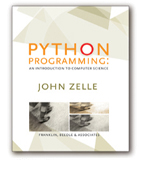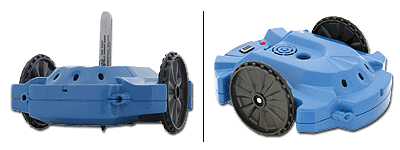Bryn Mawr College
Computer Science Department
CS 110: Introduction to Computing
Fall 2007
Course Materials
Associate Professor Douglas S. Blank
General Information
Instructor: Douglas S. Blank, 248 Park Hall, 526-6501
E-Mail: dblank (AT) cs (DOT) brynmawr (DOT) edu
WWW: http://cs.brynmawr.edu/~dblank
Lecture Hours: Tuesdays & Thursdays, 2:30 p.m. to 4:00.m.
Room: Park 338
Lab: TBA
Laboratories:
- Computer Science Lab Room 231 (Science Building)
- You will also be able to use your own computer to do the labs for this course.
Lab Assistants: The following Lab assitants will be available during the week (names and schedules will be posted by the end of this week) for assistance on lab assignments.
- Doug Blank (dblank): TBA
- Michelle Beard (mbeard): TBA
- Ashley Gavin (agavin): TBA
- Mansi Gupta (mgupta): TBA
- Anne Miller (amiller): TBA
- Marwa Muhammad (mmuhamad): TBA
- Shikha Prashad (sprashad): TBA
- Emily Stomach (estomach): TBA
Please see http://wiki.roboteducation.org/Introduction_to_Computer_Science_via_Robots for up-to-date TA hours.
These are the hours when the Lab will not be available:
- TBA
Texts & Software
Python Programming: An Introduction to Computer Science: by
John Zelle, Franklin Beedle & Associates, 2004. ISBN 1-887902-99-6
Python Software + IDLE + Myro (This software is already installed in the Computer Science Lab). The software is also available for your own computer from the CD included in your text.
Graphics Library (accompanies and distributed with the text is
also installed in the lab)
IPRE Robot Kit: These will be handed out to you in Week#2.
Introduction to Computer Science via Robots, by IPRE, 2007 (available online, click here).
|


|
Links
Course Links
- Edventure, Course Management System
- Institute for Personal Robots in Education
- HTML documentation of graphics.py
- A database of color names
Robot Videos
- The Humans are Dead and the Binary Solo
- Ben Axelrod's Robots of Today
Important Dates
- September 4: First lecture
- September 13: IPRE visitors
- TBA: Exam 1
- TBA: Exam 2
Grading
All graded work will receive a percentage score (0 to 100). At the
end of the semester, a final grade will be assigned that will be one
of the following: 4.0, 3.7, 3.3, 3.0, 2.7, 2.3, 2.0, 1.7, 1.3, 1.0,
or 0.0. This value will be calculated as a weighted average of all grades
according to the following weights:
- Exam 1: 20%
- Exam 2: 25%
- Labs & Written Work: 55%
- Total: 100%
Schedule
- Assignment #1: (Due on Tuesday, September 11, 2007, in class) Do
one of the following: Execrise 1, Exercise 2, Exercise 3, or
Exercise 4 from Chapter 1 of ICSvR
(based on your own preference). Submit a printed short paper no
longer than 3-5 pages (single spaced with 1-inch margins).
- Assignment #2: (Due on Thursday, September 20, 2007, in class):
- Read Chapter #3, in Introduction to Computer Science via Robots
- Read Chapter #2, in Programming Python
- Do exercises #2, and #3 in Chapter #3 Exercises, in Introduction to Computer Science via Robots
BONUS: Attend Wednesday's Talk on the "Philosophy of Computer Science" and write a brief summary at blog.roboteducation.org.
- Assignment #3: (Due on Thuesday, September 25, 2007, in class):
- Read Chapter #4, in Introduction to Computer Science via Robots
- Read Chapter #3, in Programming Python
- Do exercises #2, #3, and #4 in Chapter #4, Proprioception, in Introduction to Computer Science via Robots.
BONUS: Do #6 Chapter #4, Proprioception: Try writing a program to draw other shapes: the outline of a house, a stadium, or create art by inserting pens of different colors (you can write the program so that the robot stops and asks you for a new color, too).
- Assignment #4: Robo-archaeologist. Your mission is to make it into the Pyramid, take pictures of the hieroglyphics, and make it out of the tomb. Pictures.
- Assignment #5: Find the Pyramid. Your mission is to start your robot off somewhere in the lab, and let the robot find the pyramid. Bonus points if you can get very close to the pyramid without touching it, and signaling that you have found it (beep() or speak("I've found the pyramid!")). (For fun, get a bunch of your friends together and start out equi-distant from the pyramid. The winner is the first to the pyramid. Last one there is a rotten egg!
So, this assignment will require you to do two things:
- Look at all of the pixels, keeping track of the orange ones
- Decide to turn left, right, or move forward
The first part is written like:
pic = takePicture()
# initilize some variables here
for pixel in getPixels(pic):
if getColor(pixel) == 255: # bright red
# do something because they match
Now, what would help you decide what to do? If you knew where the
matching orange pixels were, that would help. You can find out where a
pixel is with:
x = getX(pixel)
y = getY(pixel)
But that is only one pixel. What you really want to know is where
all of the matching orange pixels are. But that is too much
information. You could take the average, and that would tell you the
general direction of the Pyramid. To compute the average, you need to
sum up all of the x's and the y's of the matching pixels, and then
divide by the total matching pixels. Here is a little program that
sums up the x's and y's for an entire picture::
# initialize the variables:
x = 0
y = 0
for pixel in getPixels(pic):
x = x + getX(pixel)
y = y + getY(pixel)
and then you could compute the average by dividing by the total count
of matching pixels:
# initialize the variables:
x = 0
y = 0
total = 0
for pixel in getPixels(pic):
x = x + getX(pixel)
y = y + getY(pixel)
total = total + 1
print "Average x:", x / total
print "Average y:", y / total
But that will just give you the average position of ALL of the
pixels. You'll need to only add the x's and y's of the matching
pixels, and only divide by the number that match.
Finally, you should use those values to decide to go left, right,
or straight:
if x/total > getWidth(pic)/2:
# on right half of screen
else:
# on left half of screen
But when do you go straight? Divide by two, get two halves, divide
by three and ...
Hopefully this will give you some useful hints as to how to solve the
"Find the Pyramid" puzzle.
Midterm Review
- Assignment #6: Representational Art
Read Chapter 5, Python Programming.
Draw a representation of yourself in Python using Myro that includes
your name. I'd like a copy of the picture. One easy way to get a
picture is to save it as in Postscript format. If you want to save the
picture in a file called "test.ps" you can do the following:
from myro import *
win = GraphWin()
p1 = Point(25, 50)
p1.draw(win)
p2 = Point(75, 50)
p2.draw(win)
t = Text(Point(100, 50), "Doug")
win.postscript(file="test.ps")
Then, please send me the file "test.ps", and print out your program to
hand in. You should center the name at the bottom of the picture. Feel
free to use colors. Have fun; be creative!
Results so far
- Assignment #7: Games!
You should form teams of two or three. Design a game using your
knowledge of Python and Myro. Feel free to use the Gamepad
and graphics from your book. Goal: make it fun! Due December 6, 2007,
in class.
To complete this assignment:
- Turn in (electronic and hardcopy) your source code and a user's
manual on how to play your game. Include pictures of your screen in
your manual.
- Include a section of the manual detailing the team members, and what each person did.
- Give a demo of your game for the class on December 6.
- What is computer science?
-
Hal Abelson's first day of class at MIT
Upcoming Events
Robot Conflict
October 20, 2007, at the Franklin Institute.
Engineering Politics, Good Magazine.
Urban Challenge
Created by dblank, September 3, 2007.

